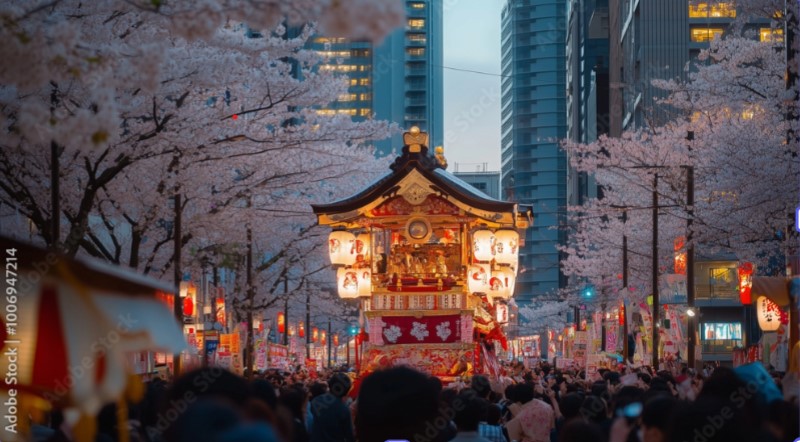※本記事にはプロモーションが含まれています。
12 Must-See Japanese Festivals: From Gion Matsuri to Yosakoi and Nebuta
From lantern-lit floats to electrifying street dances, Japan’s festivals—known as matsuri—are cultural events that bring together history, music, costumes, and community. Whether you’re planning your first trip or your tenth, here are 12 must-see festivals (plus two bonus picks!) that showcase the spirit of Japan.
- Table of Contents
- 1. Gion Matsuri(祇園祭, Kyoto)
- 2. Awa Odori(阿波おどり, Tokushima)
- 3. Nebuta Matsuri(ねぶた祭り, Aomori)
- 4. Kanda Matsuri(神田祭, Tokyo)
- 5. Tanabata Matsuri(仙台七夕まつり, Sendai)
- 6. Sapporo Snow Festival(さっぽろ雪まつり, Hokkaido)
- 7. Hakata Gion Yamakasa(博多祇園山笠, Fukuoka)
- 8. Hakone Daimyo Gyoretsu(箱根大名行列, Kanagawa)
- 9. Takayama Matsuri(高山祭, Gifu)
- 10. Atsuta Matsuri(熱田まつり, Nagoya)
- Bonus: Awa Odori Video – Join the Dance!
- Bonus: Yosakoi Festival(よさこい祭り, Kōchi)
Table of Contents
- 1. Gion Matsuri(祇園祭, Kyoto)
- 2. Awa Odori(阿波おどり, Tokushima)
- 3. Nebuta Matsuri(ねぶた祭り, Aomori)
- 4. Kanda Matsuri(神田祭, Tokyo)
- 5. Tanabata Matsuri(仙台七夕まつり, Sendai)
- 6. Sapporo Snow Festival(さっぽろ雪まつり, Hokkaido)
- 7. Hakata Gion Yamakasa(博多祇園山笠, Fukuoka)
- 8. Hakone Daimyo Gyoretsu(箱根大名行列, Kanagawa)
- 9. Takayama Matsuri(高山祭, Gifu)
- 10. Atsuta Matsuri(熱田まつり, Nagoya)
- Bonus: Awa Odori Video
- Bonus: Yosakoi Festival(よさこい祭り, Kōchi)
1. Gion Matsuri(祇園祭, Kyoto)
Date: July 1–31 (Main processions: July 17 & 24)
Overview: Gion Matsuri is Japan’s most iconic and oldest urban festival, dating back to 869 AD. What began as a ritual to appease angry gods during a deadly plague has transformed into a month-long celebration of Kyoto’s artistry, faith, and civic pride. Centered at Yasaka Shrine, the festival overflows into the city streets with grand parades, rituals, music, and communal traditions.
Yamaboko Junko: The festival’s centerpiece is the spectacular Yamaboko Junko, held on July 17 (Saki Matsuri) and July 24 (Ato Matsuri). These parades feature 33 floats—called yama and hoko—each representing a Kyoto neighborhood. Some hoko are over 25 meters tall and weigh 12 tons, constructed without nails using centuries-old techniques. Their themes depict myths, legends, and historical tales.
Each float houses musicians playing the hypnotic Gion-bayashi music. As they parade through the narrow streets, spectators in yukata cheer and photograph these mobile masterpieces.
Yoiyama Nights: The three nights before each main parade—called Yoiyoiyoiyama, Yoiyoiyama, and Yoiyama—offer nighttime float viewing, lantern-lit streets, and open-house exhibitions of family heirlooms known as Byobu Matsuri.
Travel Tips:
- Best Viewing: Shijo, Kawaramachi, and Oike streets.
- Dress Code: Wearing a yukata helps you blend in and stay cool.
- Aug 2–6: Evening parades
- Aug 7: Daytime parade and nighttime fireworks over Aomori Bay
- Rassera Land: A daytime event to view floats up close
- Book hotels 3–6 months early
- Best views near Aomori Station or reserved seating (~¥3,500)
- Shinko-sai: A grand parade of mikoshi (portable shrines), court musicians, priests, dancers, and samurai warriors on horseback, weaving through districts like Akihabara, Nihonbashi, and Marunouchi.
- Mikoshi Miyairi: Over 200 neighborhood mikoshi return to Kanda Shrine in a festive, high-energy procession.
- Best viewing: Around Kanda Shrine and Chiyoda district
- Access: JR Ochanomizu or Akihabara stations
- Come early: Crowds gather quickly along the parade route
- Best viewed at Ichibancho and Clis Road shopping arc
6. Sapporo Snow Festival(さっぽろ雪まつり, Hokkaido)
Date: February 4–11 (2025)
Overview: Sapporo Snow Festival is Japan’s most famous winter event, turning Hokkaido’s capital into a wonderland of snow and ice. Drawing over 2 million visitors, the festival features massive snow sculptures, artistic light displays, and interactive snow attractions across three city venues.
Main Venues:
- Odori Park: The main site, filled with towering snow sculptures, some over 15 meters tall, often depicting famous buildings, characters, and historical scenes
- Susukino: Known for crystal-clear ice sculptures with lighting at night, including an ice bar and ice slide
- Tsudome: Family-friendly area with snow rafting, tubing, and snow play areas
Nighttime Highlights: At Odori and Susukino, evening illumination and projection mapping shows bring the sculptures to life with music and color, creating a magical winter atmosphere.
Travel Tips:
- Dress for sub-zero temps: thermal layers, gloves, waterproof boots, heat packs
- Hotels fill 6–9 months in advance—book early or stay in nearby cities like Otaru
- Use Sapporo’s subway system for easy access between venues
Official Info:
Sapporo Snow Festival Official Site7. Hakata Gion Yamakasa(博多祇園山笠, Fukuoka)
Date: July 1–15 (Main race on July 15 at 4:59 AM)
Overview: Hakata Gion Yamakasa is an intense and energetic summer festival in Fukuoka, best known for its early-morning float race on July 15. Teams of men carry 1-ton wooden floats through the streets in a timed competition filled with speed, teamwork, and tradition. The festival honors Kushida Shrine and dates back over 770 years.
Two Types of Floats:
- Kazariyama: Decorative, stationary floats over 10 meters tall displayed in shopping areas from July 1–14
- Kakiyama: Smaller, mobile floats used for the race, carried on the shoulders of shouting participants in traditional fundoshi (loincloths)
Main Event – Oiyama: On July 15, teams start from Kushida Shrine at 4:59 AM and race through a 5 km city course. Spectators often arrive overnight to grab the best viewing spots.
Other Highlights:
- July 12: Oiyamanarashi (rehearsal run)
- July 13: Children’s Yamakasa parades8. Hakone Daimyo Gyoretsu(箱根大名行列, Kanagawa)
Date: November 3 (annually on Culture Day)
Overview: The Hakone Daimyo Gyoretsu is a historical reenactment of a feudal lord’s procession, held every year on Culture Day in Hakone Yumoto. Around 170 costumed participants recreate the sankin-kōtai process, a symbolic journey lords took to Edo (now Tokyo) during the Edo period. This family-friendly parade is rich in tradition, pageantry, and visual spectacle.
Parade Features:
- Armored
9. Takayama Matsuri(高山祭, Gifu)
Date:
- Spring: April 14–15 (Sanno Matsuri)
- Autumn: October 9–10 (Hachiman Matsuri)
Overview: Takayama Matsuri is one of Japan’s most beautiful festivals, held twice a year in the historic mountain town of Takayama. The festival is famous for its ornate wooden floats, known as yatai, which showcase traditional craftsmanship from the Edo period. Takayama’s narrow streets, lined with old merchant houses, provide the perfect backdrop.
Festival Features:
- Parade of floats with golden carvings, lacquer, and embroidered fabrics
- Night parade (yomatsuri) with illuminated floats
- Karakuri puppet performances—mechan
10. Atsuta Matsuri(熱田まつり, Nagoya)
Date: June 5 (annually)
Overview: Atsuta Matsuri is the grand annual festival of Atsuta Shrine, one of Japan’s most revered Shinto sites, believed to house the sacred sword Kusanagi-no-Tsurugi, one of the Three Imperial Regalia. The festival is a one-day event that blends solemn ritual with summer fun and ends in a dazzling fireworks show.
Daytime Events:
- Shinto rituals with court music and sacred dance
- Martial arts demonstrations like kendo and kyudo
- Outdoor stage performances: Noh, traditional
Bonus: Awa Odori Video – Join the Dance!
Did the energy of Awa Odori catch your eye? Experience the dance, sound, and crowd excitement firsthand with this official highlight video:
🎥 Watch:
▶️ Awa Odori Festival 2023 – Tokushima Highlight VideoBonus: Yosakoi Festival(よさこい祭り, Kōchi)
Date: August 9–12
Overview: Yosakoi Festival in Kochi is a high-energy, freestyle dance event where teams from all over Japan perform synchronized choreography set to custom music. Dancers use wooden clappers called naruko and wear colorful costumes. It began in 1954 and continues to grow with modern creativity and community spirit.
Features:
- Mobile stages on trucks playing original team music
- Children’s and senior teams participate alongside professionals
- Great for photographers: motion, emotion, and bold visuals
🎥 Watch:
▶️ Yosakoi Festival 2023 – Kochi Highlight VideoOfficial Info:
Kochi Yosakoi Official Website
- Armored
2. Awa Odori(阿波おどり, Tokushima)
Date: August 12–15 (Every year)
Overview: Awa Odori is Japan’s largest traditional dance festival, attracting over 1.3 million people to Tokushima City each summer. With lively call-and-response chants, rhythmic shamisen and taiko drums, and energetic dancers moving in sync, the festival is a celebration of joyful chaos. What makes Awa Odori so special is that it’s not just a performance—everyone is encouraged to join the dance.
Historical Roots: The origins date back over 400 years to the feudal era, allegedly inspired by drunken revelry at the opening of Tokushima Castle. The spirit of participation is embodied in the chant: “Odoru ahou ni miru ahou. Onaji ahou nara odorana son son!” (“The dancers are fools, the watchers are fools. If both are fools, you might as well dance!”)
Festival Experience: Thousands of dancers in ren teams fill downtown Tokushima with synchronized steps and colorful costumes. Women dance gracefully in straw hats and yukata, while men leap and stomp to the beat. Visitors can participate by joining Date: August 2–7 Overview: Nebuta Matsuri is one of the Three Great Festivals of the Tōhoku region, famous for its massive illuminated paper floats. Each float, called a nebuta, is hand-crafted with vivid colors and depicts warriors, gods, or mythical creatures. They parade through Aomori City with music and hundreds of dancers called haneto shouting “Rassera! Rassera!” The Floats: These paper-and-wire structures can reach 9 meters wide and 5 meters tall. Built over months, the floats are wheeled through the streets and spun to engage the crowd. Many draw from Japanese myths or NHK’s Taiga Dramas. Dancing: Anyone can join as a haneto dancer if wearing the correct costume. You can rent one locally. The bouncing steps and energetic calls make it a lively experience. Event Highlights: Travel Tips: Official Info: Date: Mid-May (odd-numbered years) Overview: Kanda Matsuri is one of Tokyo’s most prestigious festivals, held every two years in May. Originating in the early Edo period, it honors the deities of Kanda Myojin Shrine and celebrates prosperity, good fortune, and Tokyo’s merchant spirit. The festival brings a vibrant mix of sacred ritual and urban energy to central Tokyo. Main Events: Historical Note: Tokugawa Ieyasu attributed his victory at Sekigahara to Kanda Myojin’s divine protection, and the festival was elevated to state ceremony status in the Edo period. Travel Tips: Official Info: Date: August 6–8 (annually) Overview: Tanabata, or the Star Festival, celebrates the romantic tale of two celestial lovers, Orihime and Hikoboshi, who reunite only once a year. In Sendai, this tradition is elevated to a grand festival of stunning handmade decorations and poetic atmosphere. The Decorations: Over 3,000 bamboo and paper streamers hang in arcades and public spaces, some over 5 meters long. Each set represents a prayer for things like good health, prosperity, and weaving skill, and many are created by local artists and schools. Awards are given for the most beautiful displays. Festival Features:
Nebuta Festival Official Site (JP) |
Japan Guide: Nebuta Festival4. Kanda Matsuri(神田祭, Tokyo)
Kanda Shrine Official Site |
Japan Travel: Kanda Matsuri5. Tanabata Matsuri(仙台七夕まつり, Sendai)



コメント